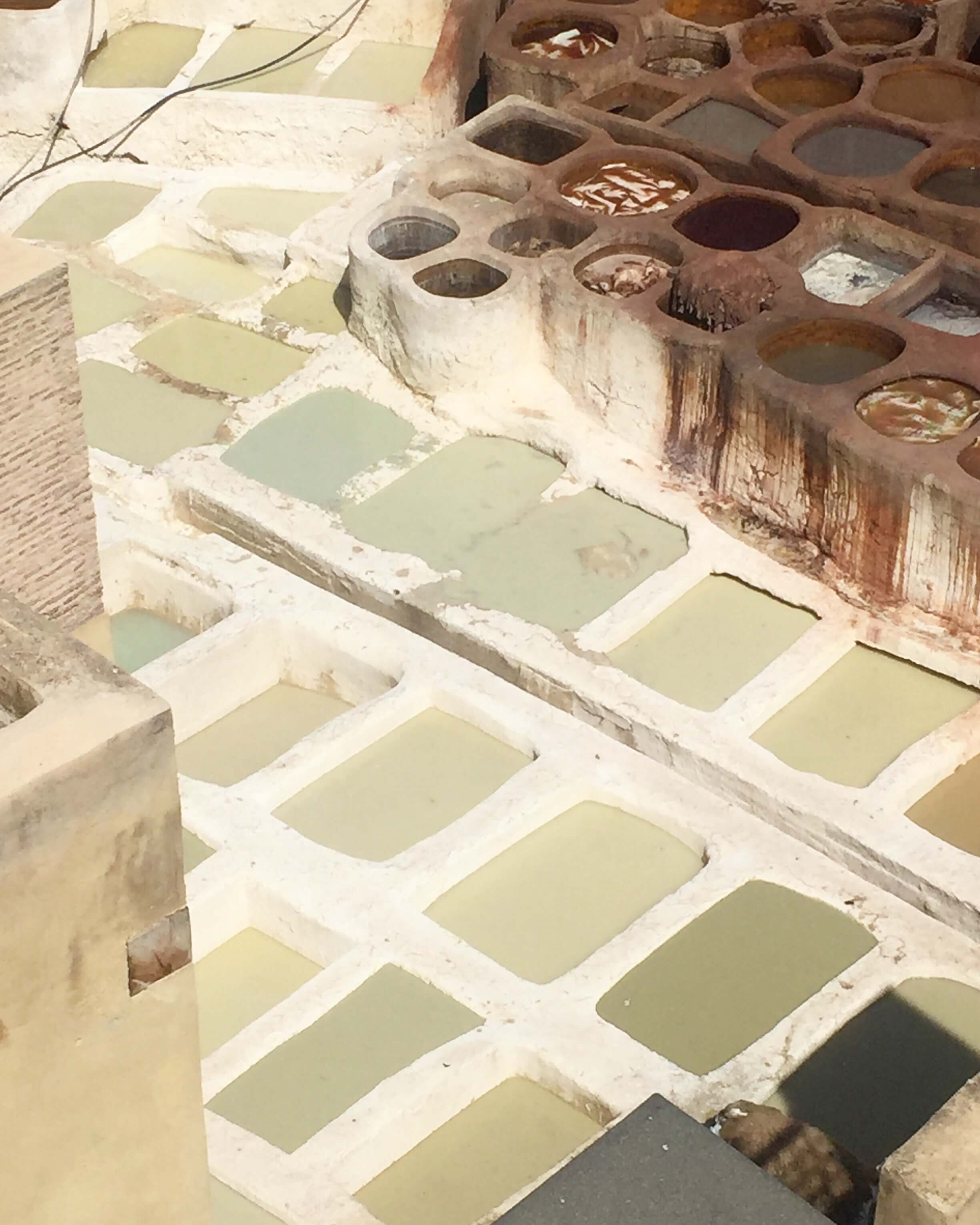
[ A Z A R · E T H I C S ]

Chouara Leather Tanneries. Fez, Morocco.
As artisans and designers who work within the fashion industry and seek to build a sustainable business model, we feel directly involved in the debates taking place around the use of leather and its renowned impact on our environment. Most debates are centered around animal rights and environmental issues, especially regarding the high levels of methane that cows contribute to the Earth’s atmosphere.
But how is animal skin transformed into leather? What would be of these animals if they were not used for leather and converted into new items? Besides our personal and professional reasons to work with this material, (about which you can read here) we would like to talk about some basic but important notions that revolve around this topic. After engaging in some debates lately, we noticed that there are some misconceptions among the general public, or a simple lack of awareness regarding animal and vegan leathers. As such, we would like to take our research and our considerations on this topic a step further. Whatever conclusions we might draw from this, the more informed we are, the more conscious our decision will turn out to be at the time of consuming leather.
But how is animal skin transformed into leather? What would be of these animals if they were not used for leather and converted into new items? Besides our personal and professional reasons to work with this material, (about which you can read here) we would like to talk about some basic but important notions that revolve around this topic. After engaging in some debates lately, we noticed that there are some misconceptions among the general public, or a simple lack of awareness regarding animal and vegan leathers. As such, we would like to take our research and our considerations on this topic a step further. Whatever conclusions we might draw from this, the more informed we are, the more conscious our decision will turn out to be at the time of consuming leather.
 Tanning vats · Chouara Leather Tanneries · Fes El Bali
Tanning vats · Chouara Leather Tanneries · Fes El Bali
Genuine Leather · A Brief History From Its Origins Until Today
Leather has been one of the first-ever processed materials in mankind’s history, not only as a practical resource of protection, warmth and tools fabrication, but also as a cultural, religious and social signifier.
From a historical perspective, there is a strong bond between humankind’s development and leather. During millennia, human survival depended on hunting and ranching, and this established a clear correspondence between leatherwork and food disposal. The animals were hunted or raised for their meat, and the remaining parts of the animal were transformed into shelter or tools. This survival aspect added an emotional and cultural attribute to the material, creating a deep connection between the animals and men.
Leather has been one of the first-ever processed materials in mankind’s history, not only as a practical resource of protection, warmth and tools fabrication, but also as a cultural, religious and social signifier.
From a historical perspective, there is a strong bond between humankind’s development and leather. During millennia, human survival depended on hunting and ranching, and this established a clear correspondence between leatherwork and food disposal. The animals were hunted or raised for their meat, and the remaining parts of the animal were transformed into shelter or tools. This survival aspect added an emotional and cultural attribute to the material, creating a deep connection between the animals and men.
Although this situation is very different to current post-industrial revolution societies, we can still find traces of this cultural bond in those countries where stockbreeding and equine culture is still lived as a source of income or as a cultural expression. Think about landscapes in Argentina, Japan or Morocco. Leatherwork subsists in the outskirts of the industrialisation, as skilled craftsmanship and cultural significance until today.
Besides this, there is another situation to be considered. In many developing countries, people rely on farming for income and have few other employment options. According to the UN Food and Agriculture Organization, livestock provides farmers with many economic benefits, including a means of reducing the risks associated with crops, a source of regular income from sales of milk and meat, and opportunities to increase employment through on-and off-farm work.
Is it fair to demand leather-free products from countries where subsistence farming is the primary means of survival? Moreover, is it ethical to refuse to purchase from artisans for whom leatherworking is a sacred and traditional craft?
Chrome Tanning Vs. Vegetable Tanning
We will let you find the answer to these questions and proceed to the technical issues, which provide important considerations to this debate.
Once the animal’s life span ends, its body can be treated like rubbish, letting it decompose, or we can use them for valid purposes. If we choose to make leather, it is necessary for the animal’s skin to undergo a tanning process, a chemical procedure that grants softness and flexibility to the skin, maintaining its whole volume and transforming it from a highly complex and difficult material to a very sophisticated and malleable one.
There is much to say concerning the tanning process. Briefly, we can say that nowadays, most of the tanning procedures used worldwide follow two methods: chrome tanning or vegetable tanning.
We will let you find the answer to these questions and proceed to the technical issues, which provide important considerations to this debate.
Once the animal’s life span ends, its body can be treated like rubbish, letting it decompose, or we can use them for valid purposes. If we choose to make leather, it is necessary for the animal’s skin to undergo a tanning process, a chemical procedure that grants softness and flexibility to the skin, maintaining its whole volume and transforming it from a highly complex and difficult material to a very sophisticated and malleable one.
There is much to say concerning the tanning process. Briefly, we can say that nowadays, most of the tanning procedures used worldwide follow two methods: chrome tanning or vegetable tanning.
 Chouara Leather Tanneries · Fes El Bali
Chouara Leather Tanneries · Fes El Bali
In the first case, the animal’s skin is treated with chrome-salted solutions and other specific chemical products. This process is relatively quick, taking a few hours for thinner and smaller skins and about a day for cowhides. Sadly, this process is very polluting for the environment and is the most widespread method used in massive industries. There is still a high demand for this kind of leather because it’s lightweight and highly resistant, whilst at the same time, it is possible to obtain vibrant colours, which is not achievable through vegetable tanning. On the other hand, this type of leather is not suitable for manual work, so it is used less often by artisans, since it is too extensible and soft. However, it has been developed to be manipulated in fast machines, with mass-production techniques.
In the vegetable tanning process, the solution is prepared with tree’s barks, branches, leaves, and water. Despite involving fewer chemicals, it requires large quantities of water that then flows into rivers, once processed, contributing to their pollution. This process is much slower than chrome tanning; it can take around three months to get a 3mm piece of leather that will go on to be used for bags. Whereas for thicker leathers, such as those used for shoe soles, this process can be prolonged to a year or more. Last but not least, the vegetable tanning has a considerable advantage on chrome tanning: vegetable tanned leathers are biodegradable, while chrome-tanned ones are not.
 Sara wandering through the streets of Fez, Morocco, 2019.
Sara wandering through the streets of Fez, Morocco, 2019.What About Going Vegan?
This might be a logical question after researching that genuine leather has its pros and cons, making it harder to take an easy and comfortable position in this debate.
Vegan leathers have clearly become a popular option for people avoiding the use of animal products. But what are they made of?
The most important reasons for leading laboratories and industries to research and produce fake leathers has been because of its lower cost and higher producibility for an increasing consumer market, and of course, the relatively short and easy process needed to get it if we compare it with what we have just considered about leather tanning. Moreover, they also satisfy the ever-changing and ever-growing demand for colours and textures that are not achievable with animal leathers.
This might be a logical question after researching that genuine leather has its pros and cons, making it harder to take an easy and comfortable position in this debate.
Vegan leathers have clearly become a popular option for people avoiding the use of animal products. But what are they made of?
The most important reasons for leading laboratories and industries to research and produce fake leathers has been because of its lower cost and higher producibility for an increasing consumer market, and of course, the relatively short and easy process needed to get it if we compare it with what we have just considered about leather tanning. Moreover, they also satisfy the ever-changing and ever-growing demand for colours and textures that are not achievable with animal leathers.
However, though vegan leather may not involve animals, it does involve chemicals. Most vegan leathers nowadays are made from polyurethane (PU), a plastic-based synthetic manufactured from fossil fuels that takes a long time to break down once it reaches the end of its useful life. Polyurethane releases hazardous toxins during manufacturing, as well as the oil-based polymers it’s made with, which make use of fossil fuels, making this type of vegan leather not all that eco-friendly.
There are some additional characteristics to consider: fake leathers have no pores, so they are not breathable. They are also easily damageable and tend to crack with usage. Holes can’t be repaired, for example, and they result in being highly sensitive to warmth. They tend to adhere to surfaces and lose or transfer their colour easily to other garments or surfaces. As a result, their potential usability over time is extremely limited in comparison to genuine leather.
Chouara Leather Tanneries · Fes El Bali
That said, more sustainable vegan leathers are being researched, made from a vast array of materials such as cork, pineapple leaves, soy, kelp, mushroom mycelium, and even kombucha. They undoubtedly help to limit the addition of more waste to landfills and are completely bio-degradable, but unfortunately, they are still too compromised in terms of strength, durability, and producibility to be a suitable alternative for all kind of leather products.
There is much to think about on this topic and jumping to one conclusion is hard after just a bit of research into the issue. Nevertheless, we all need to respect our ethos and find a position where we feel comfortable, as consumers, as well as producers.
We would love to know your views on this too. If you wish to, you can read ours in this article: Why We Choose To Use Genuine Leather Instead Of Vegan Leather.
[ TAKE ME BACK ]
[ HOME ]
